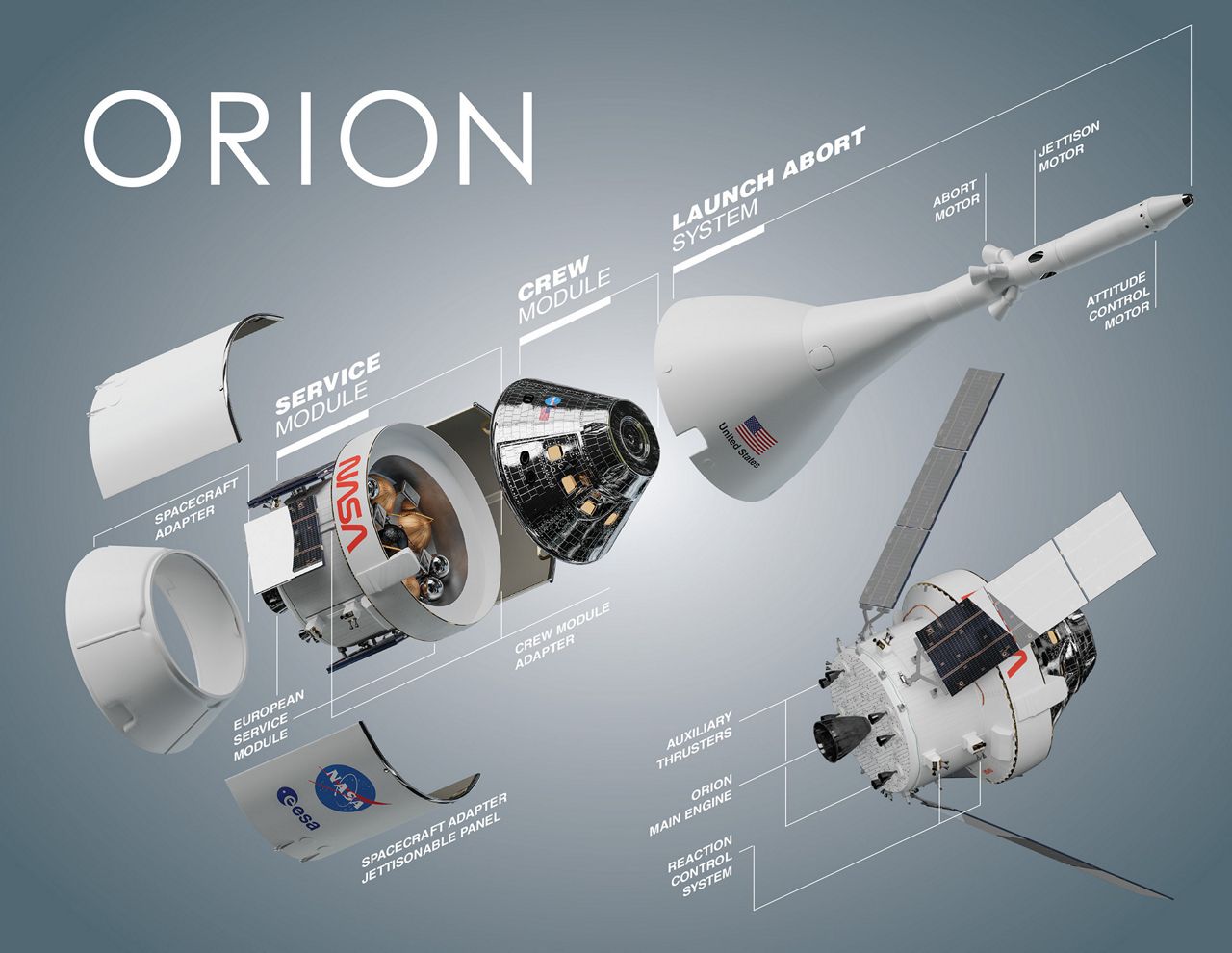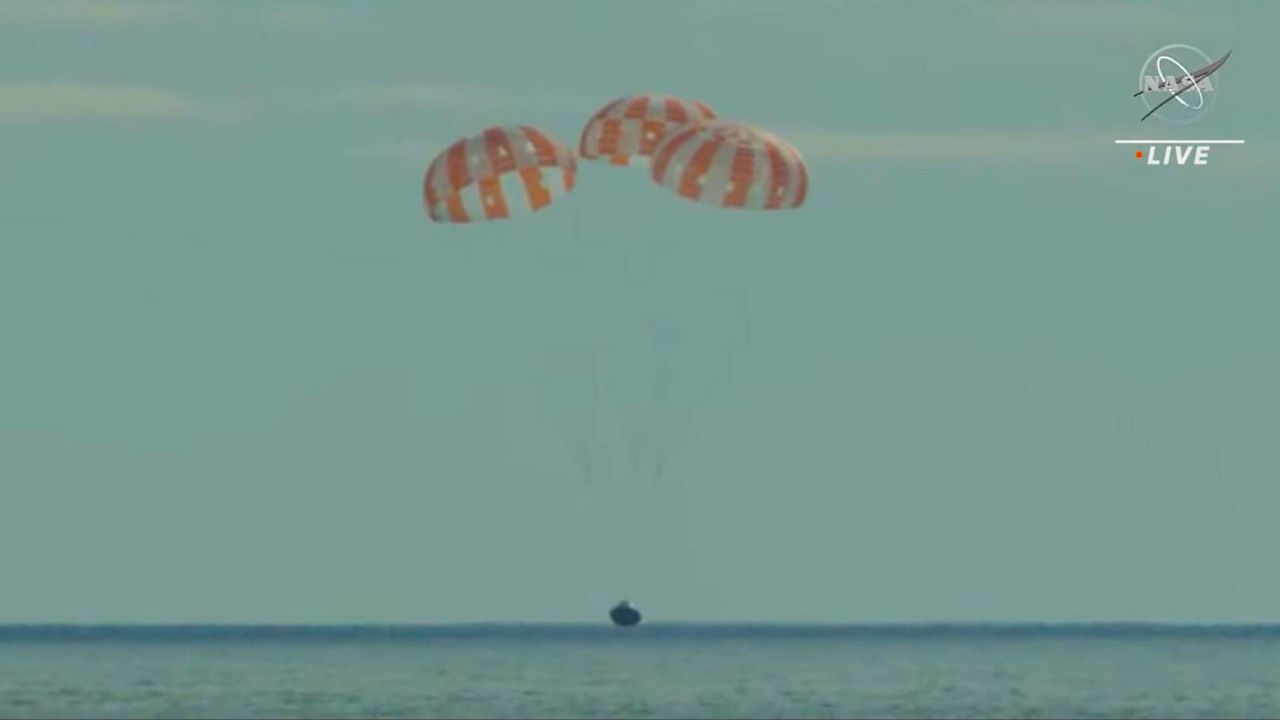The Orion spacecraft returned to Earth in a successful splashdown Sunday after its 25-day mission to the moon and back.
What You Need To Know
- Orion splash downed at around 12:40 p.m. EST., on Sunday, Dec. 11
- There are a few steps that the Orion spacecraft needs to take before its splashdown
- RELATED coverage:
- 🔻Scroll down to watch the splashdown🔻
From lifting off at Launch Pad 39B at the Kennedy Space Center on Nov. 16, Orion splashed down off the coast of Baja California on Sunday, Dec. 11, at around 12:40 p.m. EST, just one minute later than anticipated.
During a mission briefing on Thursday, Judd Frieling, an ascent and entry flight director for Artemis 1 mission, explained that Orion was originally going to land off the coast of San Diego, but due to weather constraints, the new splashdown location was moved 300 nautical miles south, off Guadeloupe Island, which is off Mexico’s Baja California.
As Orion returned to Earth, it was moving at about 25,000 mph and the nearly 11-foot-tall craft experienced temperatures of about 5,000 degrees Fahrenheit.
However, the planet’s atmosphere initially slowed Orion down to between 300 mph to 325 mph before the parachutes were deployed to help the spacecraft slow down even more.
Orion did not make such a big splash thanks to 11 parachutes that comprised of 36,000 square feet of canopy material. And the canopy was attached to the top of Orion by “more than 13 miles of Kevlar lines that are deployed in series using cannon-like mortars and pyrotechnic thrusters and bolt cutters,” NASA described.
NASA's mission control called the splashdown a "textbook" re-entry and the space agency’s Administrator Bill Nelson said he was "overwhelmed" of the splashdown.
"It's historic because we are going back to space, to deep space, with a new generation," Nelson said, adding, "... This is a defining day" for not just Americans, but for the human race.
“It’s a new day. A new day has dawned and the Artemis generation is taking us there,” he said.
Once Orion was safely back on Earth and floating in the Pacific Ocean thanks to five inflatable devices to keep it from sinking, the transport dock ship U.S.S. Portland was on its way to retrieve the craft and both vessels will make their way back to the Naval Base San Diego.
Orion Splashdown Countdown
Mission Specs:
- Space Launch System rocket: 322 feet tall
- Orion: 10 feet, 11 inches tall and 16.5 feet in diameter
- Mission Duration: 25 days, 11 hours, 36 minutes
- Total mission distance: About 1.3 million miles
- Orion's speed once it returns to Earth: 25,000 mph
- Temps on Orion's heat shield: 5,000 degrees Fahrenheit
Why the mission and splashdown are important
Despite the Artemis I mission having issues getting off the ground (from liquid hydrogen leaks to hurricanes), the Nov. 16, 2022 launch is a date that will go down in history as humans' first step to returning to the moon in nearly 50 years.
From going to the moon and orbiting it (and seeing the dark side of Earth’s natural satellite), Orion’s mission has gone well, so far.
The uncrewed Artemis I mission had many objectives: Having the Space Launch System rocket send the Orion spacecraft up into space and having Orion reach the moon and then slingshot the little craft back to the little round Earth.
Granted, that is an oversimplification of the mission and the splashdown is important and it is not just because NASA wanted its spacecraft back.
From beginning to end, it was a series of tests and mission objectives to see if the Space Launch System rocket and Orion could meet each one, besides getting off the ground.
For example, Cmdr. Moonikin Campos — not a living person — is in the commander’s seat of Orion wearing a spacesuit decked out in sensors to document the acceleration and vibrations of the launch and mission, plus take radiation measurements as the craft flies through space.
Another test was to see how well the parachutes worked. In fact, the space agency went into detail about how the parachutes were used.
“Parachute deployment begins at an altitude of about five miles with three small parachutes pulling the forward bay covers away. Once the forward bay cover separates, two drogue parachutes will slow and stabilize the crew module for main parachute deployment. At an altitude of 9,500 feet and a spacecraft speed of 130 mph, three pilot parachutes will lift and deploy the main parachutes. Those 116-foot-diameter parachutes of nylon broadcloth, or ‘silk,’ will slow the Orion crew module to a splashdown speed of 20 mph or less.”
Another test was to see if Orion broke apart before it re-entered Earth, which was planned and successful.

Orion is made up of three main sections: The launch abort system, the crew module and the service module.
The launch abort system (the part that looks like a nose cone) was released right after launch when the craft entered space.
But as the Orion nears Earth, the service module (which is home to Orion’s main engine and eight auxiliary thrusters and decked out in solar panels) detached itself from the crew module.
And once Orion hit Earth’s atmosphere, it was a hot time, which goes to a very big mission objective.
Once NASA recovers Orion and brings it back to Florida, engineers can find out just how well the craft’s 1,300 thermal protection system tiles protected it from the coldness of space to the extreme heat of re-entry.
Engineers and researchers have a lot of data to collect and go over before even attempting the Artemis II mission in 2024, where human astronauts will fly to the moon to orbit Earth’s lunar sister before coming back.
And if all goes well, the big mission — Artemis III — will take place in 2025, when humans will return to the surface of the moon.



